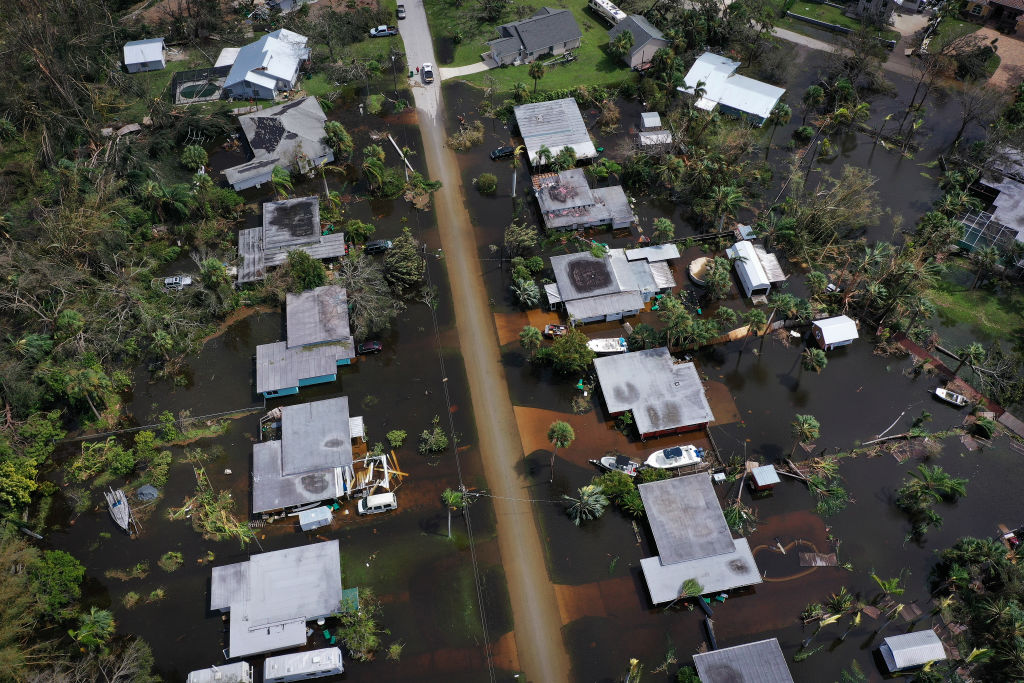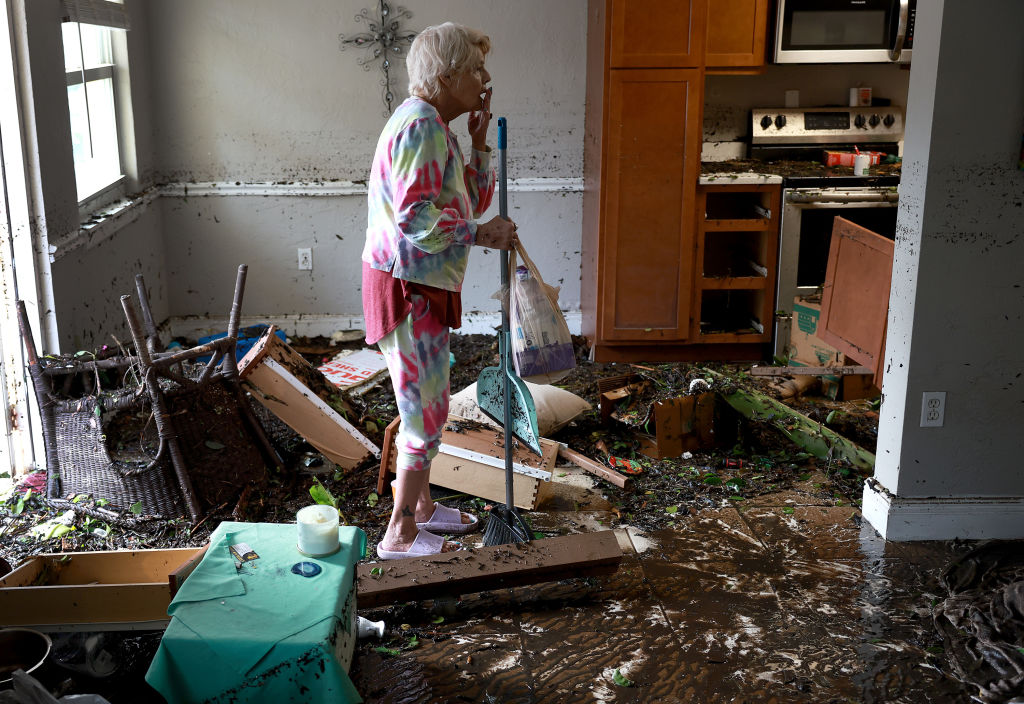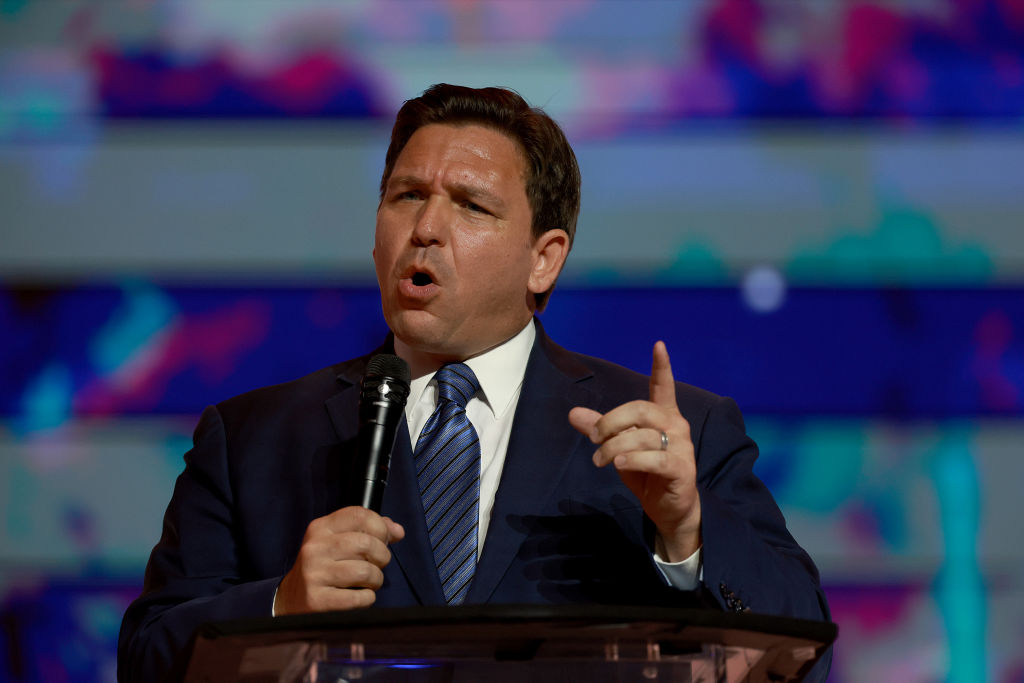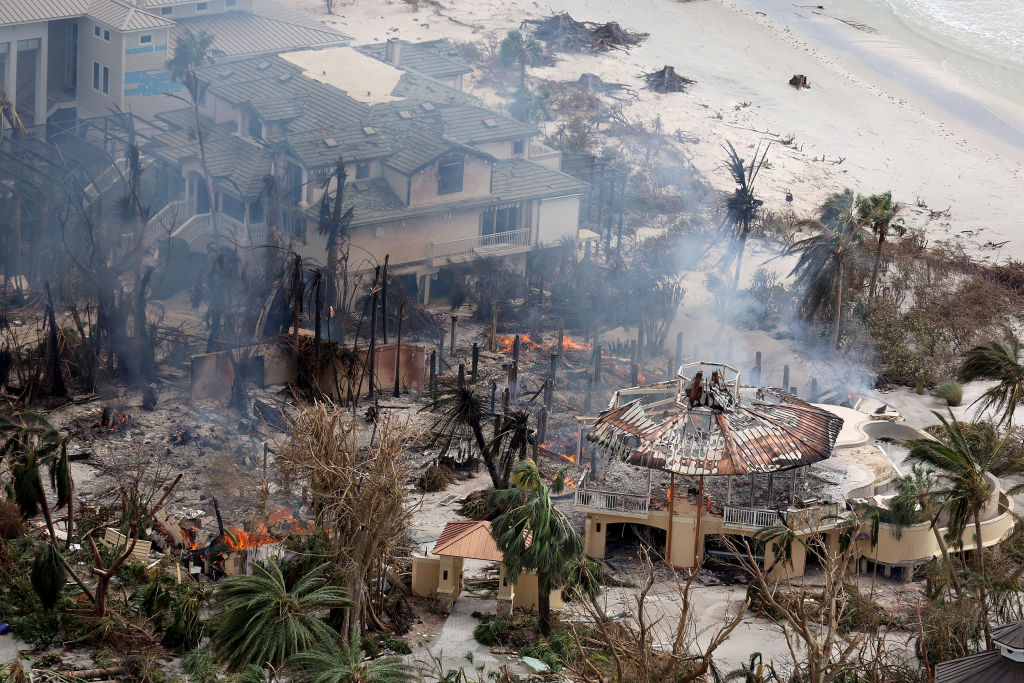
Three days after Hurricane Ian made landfall in Florida on Sept. 28 as a Category 4 storm, Johnny Aburto arrived in Port Charlotte, a mostly white community of 64,000, popular with retirees, on the state’s southwestern coast. The town suffered extensive damage during the storm: roofs blown off, homes flooded, power lines downed. There is a lot of work to be done.
Aburto, 42, is here to do it. Originally from Nicaragua, he is part of a large, informal, overwhelmingly immigrant workforce that travels the U.S. cleaning up after increasingly frequent climate-related disasters. Once a hurricane hits, these crews are bussed in by contractors desperate for workers, or they drive to the area themselves and wait in Walmart or Home Depot parking lots to be picked up for a day’s work. Aburto, a skilled laborer, was in New Orleans after Katrina in 2005, Baton Rouge after Louisiana’s floods in 2016, Panama City Beach after Michael in 2018, and Lake Charles after Laura in 2020. “These kinds of events really affect people,” he says. “We do our bit to help them.”
In Port Charlotte, Aburto is now busy covering roofs with tarpaulins—a crucial first step to keep homes safe from future rain, so that power can be restored and residents can come back. He’s also cleaning out soaked debris from interiors. When that kind of work is done, he says, many of his colleagues will stay on to make more permanent repairs.

Florida needs people like Aburto. Ian, one of the strongest storms ever to hit the U.S. mainland, was not only deadly—with at least 101 victims recorded so far—it was also hugely destructive. With homes torn open and farms devastated, insurance claims are expected to reach close to $60 billion, according to projections from risk modeling firm Verisk. And while Ian also hit South and North Carolina, Florida accounts for virtually all of the U.S.’ losses. It could be the most expensive storm in the state’s history, and rebuilding efforts will take months, if not years.
Migrant workers face mixed reception in Florida
But these workers—which include a mix of documented and undocumented migrants, according to labor advocates—face a strange kind of welcome. Florida’s Republican governor Ron DeSantis has spent the last year waging a crusade to keep migrants out of the state. DeSantis has championed a law enforcement crackdown on migrants who are in Florida illegally, and staged brazen political stunts using migrants to challenge the Biden administration’s relaxation of Trump-era migration policies.
More from TIME
Read more: See the Devastating Toll of Hurricane Ian in Florida
So far, the residents of Charlotte County, which voted overwhelmingly for Donald Trump in 2020, are happy to see workers like Aburto showing up to fix their towns. But that may not last, says Daniel Castellanos, a 52-year-old director of workforce engagement at Resilience Force, a labor organization that advocates for disaster clean-up workers. “[Port Charlotte] has a lot of older white people, and they don’t understand the customs of Latin American people,” says Castellanos, who came to the U.S. from Peru. “They are accepting us right now because they need us, but later, [as migrants settle in for months or years of work] I think there may be some conflicts.”
In the wake of the storm, DeSantis has suspended a bitter feud with President Biden, with the pair set to meet on Wednesday as Biden visits towns decimated by Ian.
Castellanos says he hopes the governor will offer migrants a similar break from hostilities. “We aren’t in the U.S. to do bad things. We are not against him. We’re here to help him—to rebuild the cities of his state,” he says. “It is very important to us to help. But it is also very important to be respected.”
DeSantis’ crusade against migrants
Over the coming days and weeks, thousands of migrants, originally from places like Central America and Venezuela, will arrive in southwest Florida’s hurricane-ravaged towns. Since its staff arrived in the region on Sept. 29, Resilience Force says it has met migrant workers who have traveled from Miami, North Carolina, and Louisiana. On Sunday, the New York Post reported that vans had picked up dozens of migrants in New York City, with one driver saying he was hired by “a water and debris company.”

They are arriving less than three weeks after DeSantis used 48 Venezuelan migrants in a bold effort to draw the national spotlight to migration. On Sept. 14, DeSantis used taxpayer funds to pay for two planes to transport the migrants from San Antonio, Texas, to Martha’s Vineyard, Mass., to the surprise of local officials there. The migrants had been recruited to join the flights with false promises of pre-arranged jobs and other assistance.
“We’ve worked on innovative ways to be able to protect the state of Florida from the impact of Biden’s border policies,” DeSantis said afterwards. Even though these migrants weren’t anywhere near his state to begin with, he claimed that the scheme meant that “the chance that they come to Florida goes down dramatically.”
Read more: How DeSantis Handles Hurricane Ian Will Shape His Political Future
DeSantis’ flights followed similar moves by the Republican governors of Texas and Arizona, who together have bussed some 10,000 migrants from their states to Washington D.C. since spring. Political analysts say the transportations are an attempt to fire up an anti-immigration Republican base ahead of the 2022 midterms in November—when DeSantis faces re-election. Migration advocates say the governor’s actions revealed contempt for some of the most vulnerable people in the country. DeSantis, meanwhile, has pledged to arrange more flights.
The Florida governor’s war on migrants goes deeper than political theater. In June, DeSantis signed a sweeping anti-immigration bill into law. It bans businesses in the state from working with companies that help the federal government to relocate undocumented migrants to Florida. It also forces law enforcement in Florida to collaborate unusually closely with Immigration and Customs Enforcement (ICE), deputizing local officers for some ICE tasks.
Florida’s climate resilience needs
Such a hostile environment creates “enormous difficulties” for migrant workers doing disaster recovery work in Florida, says Saket Soni, a labor organizer who founded Resilience Force in 2015. (The group advocates directly for around 2,000 disaster rebuild workers, helping them to find jobs and avoid exploitation.) In 2018, during clean up efforts in Bay County, Fla. following Hurricane Michael, Soni says undocumented workers were “routinely” detained and transferred to ICE detention. Others were threatened with a call to ICE by their employers when they demanded payment for work. “Workers have to override enormous fears to keep doing this work,” Soni says.

If workers can’t override those fears in the future, it could be a problem for Florida. Even before Ian, the state’s construction industry was facing an acute labor shortage after a surge in activity following the pandemic. Now, demand is exploding, Soni says. “We have been fielding constant calls from contractors who need skilled workers.”
Read more: Why Atlantic Hurricanes Are Getting Stronger Faster Than Other Storms
The tension between Florida’s post-disaster needs and its hostility to migrants may worsen in future. Scientists say climate change is making super destructive storms like Ian a more likely occurrence. Higher temperatures as a result of global warming allow air to carry more moisture and hurricanes to intensify faster. Rising sea levels, meanwhile, make storm surges worse.
DeSantis has been clear that Florida—often considered the most climate-vulnerable state in the U.S.—must do more to prepare for those risks. During his mandate, DeSantis has allocated hundreds of millions of dollars to projects to make Florida more resilient to extreme weather, and appointed a chief resilience officer to oversee them. (At the same time, the governor has aggressively fought efforts to stop climate change from happening in the first place, banning both local governments and investors in Florida from pursuing clean energy goals, arguing that these “discriminate” against fossil fuel companies.)
Soni hopes the post-Ian recovery, which will take years, could help DeSantis to see that his resilience agenda is not aligned with his migration agenda. “People form new relationships after tragedies,” he says, citing expressions of “extraordinary gratitude” from homeowners and local officials for immigrant workers in the wake of previous storms. ”I think this hurricane might make people in Florida, including Governor DeSantis and his circle, change their minds about the place of immigrants in their state.”
More Must-Reads from TIME
- How Donald Trump Won
- The Best Inventions of 2024
- Why Sleep Is the Key to Living Longer
- Robert Zemeckis Just Wants to Move You
- How to Break 8 Toxic Communication Habits
- Nicola Coughlan Bet on Herself—And Won
- Why Vinegar Is So Good for You
- Meet TIME's Newest Class of Next Generation Leaders
Write to Ciara Nugent at ciara.nugent@time.com